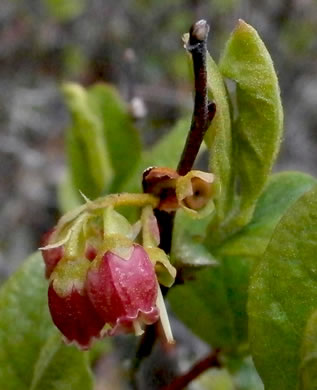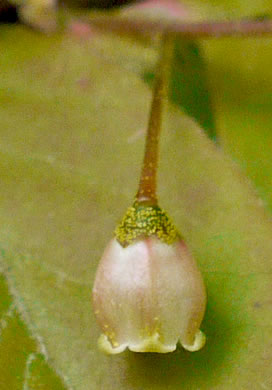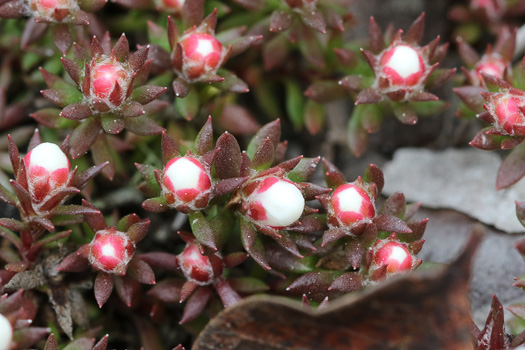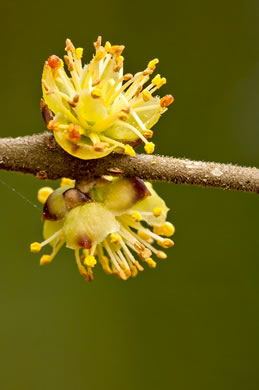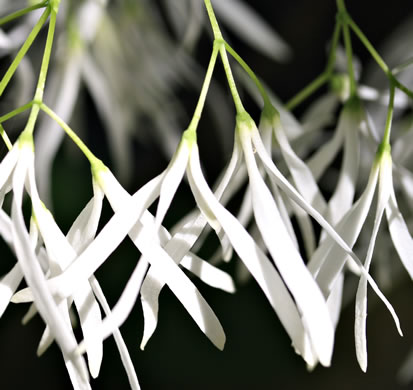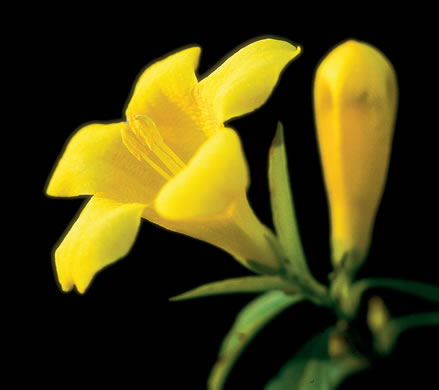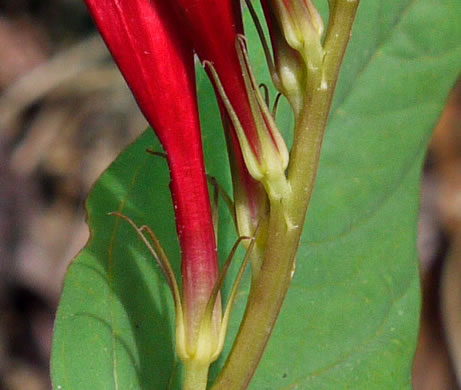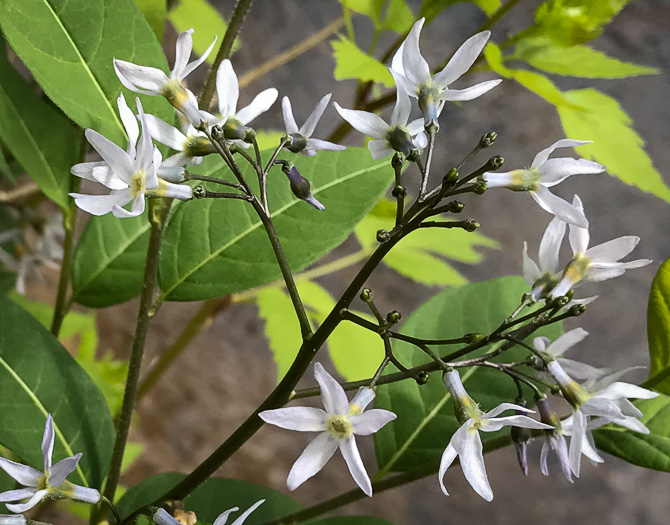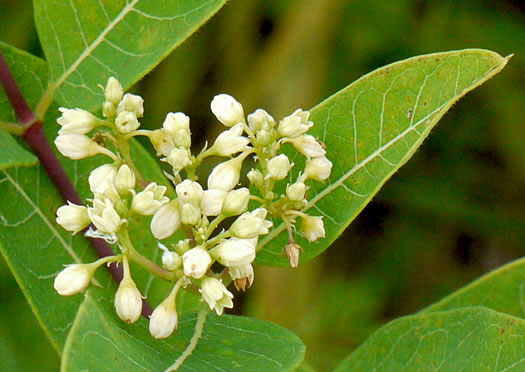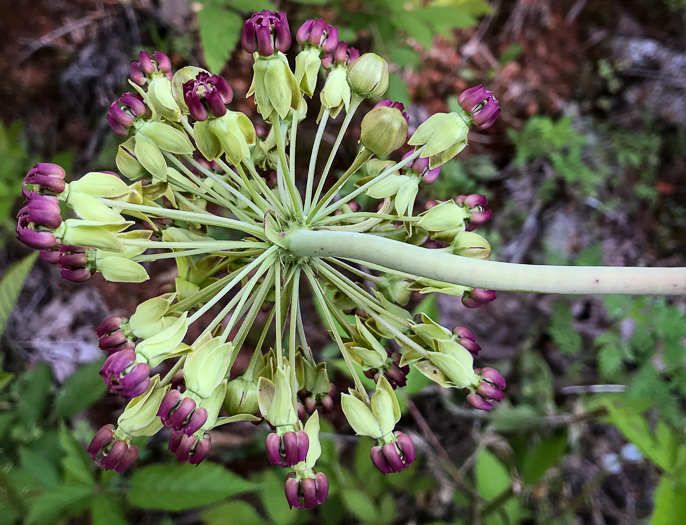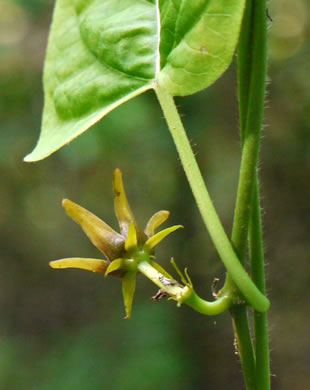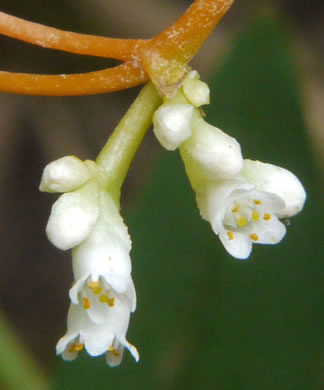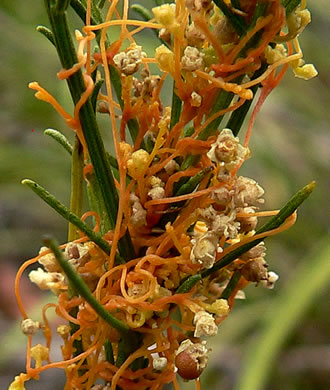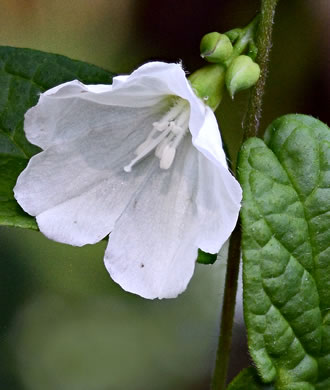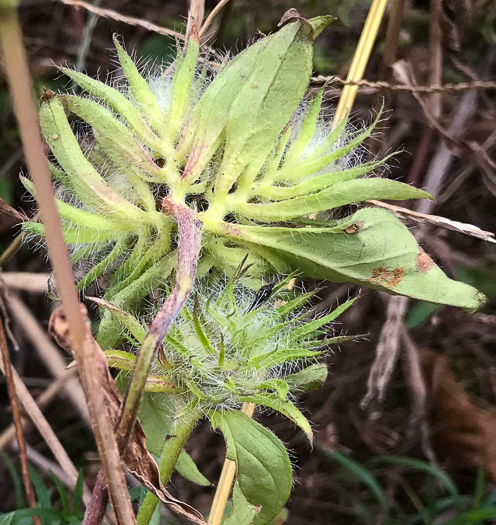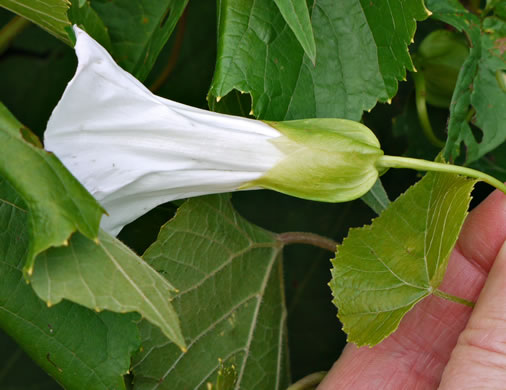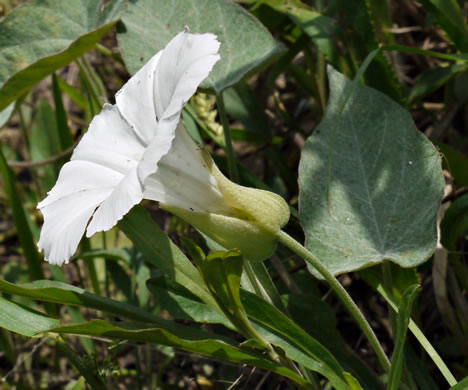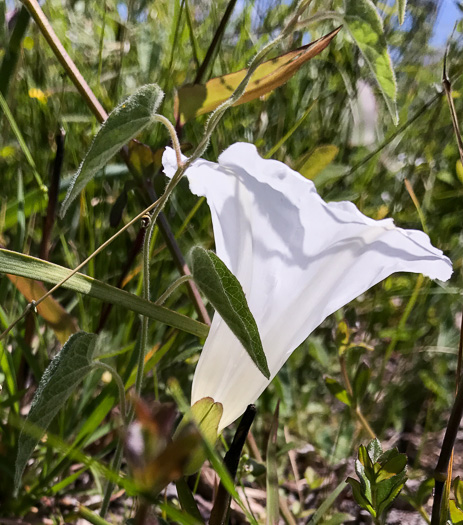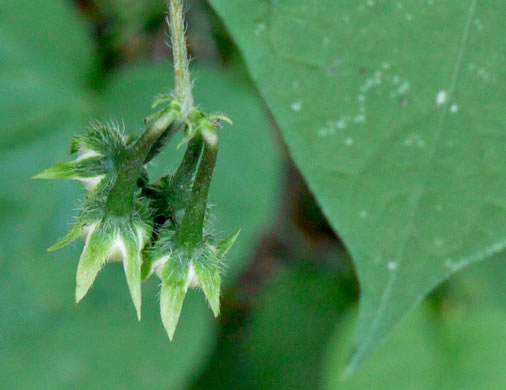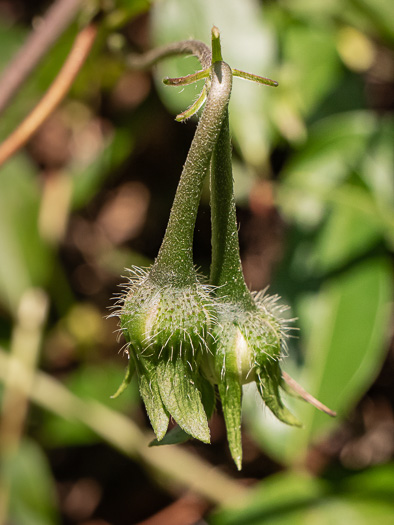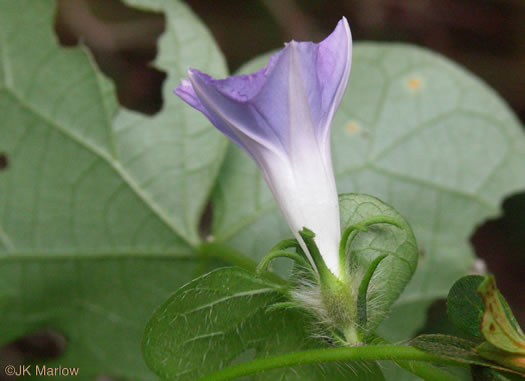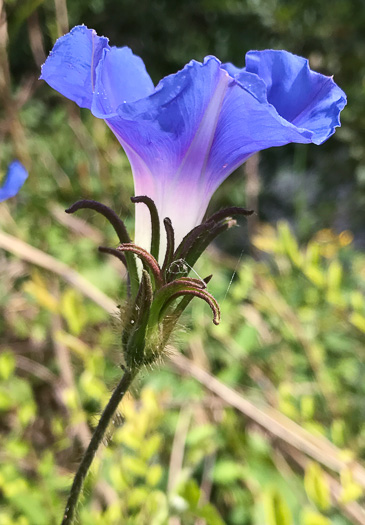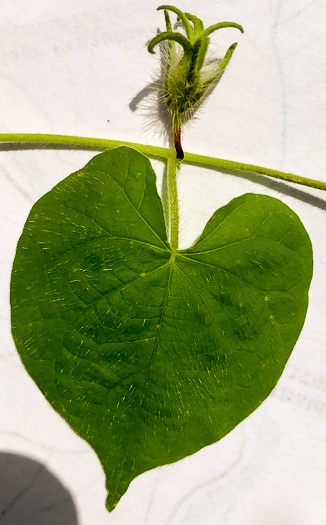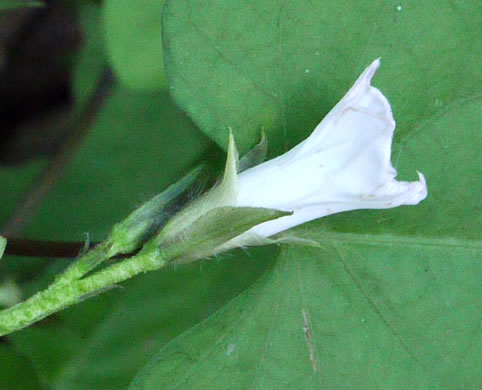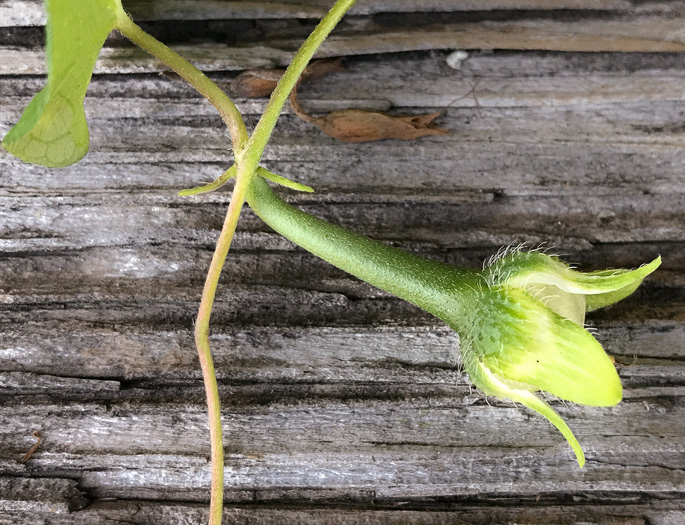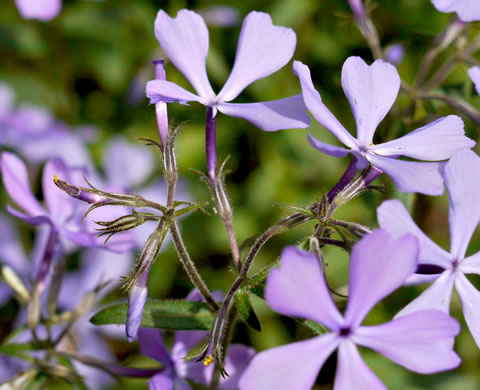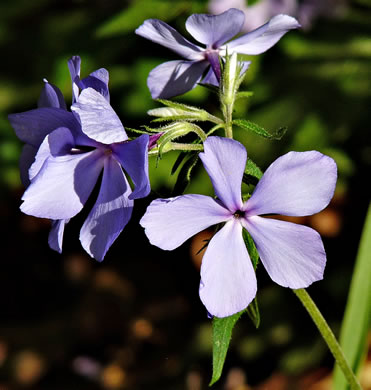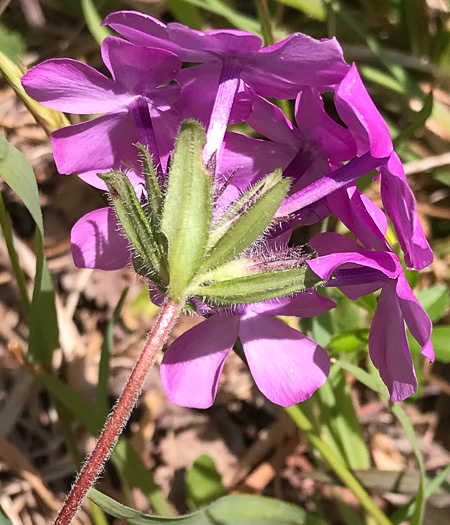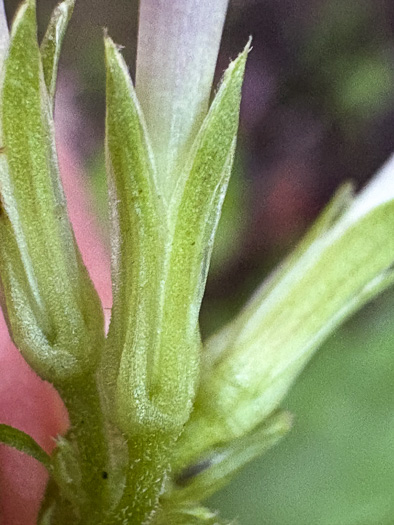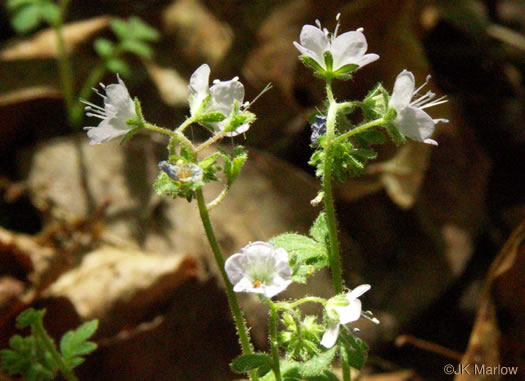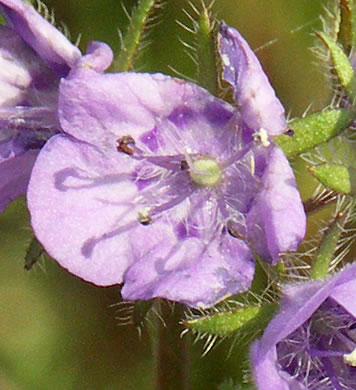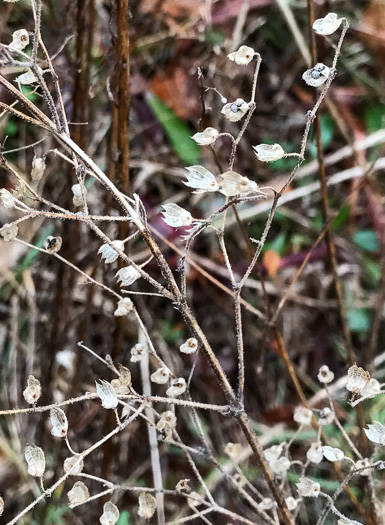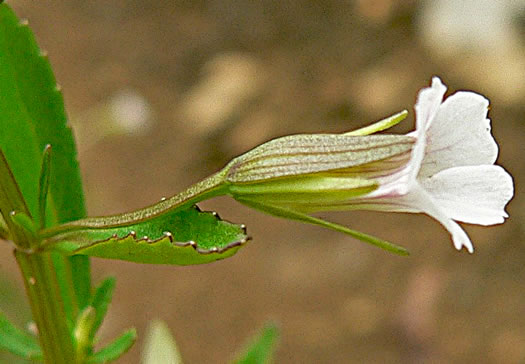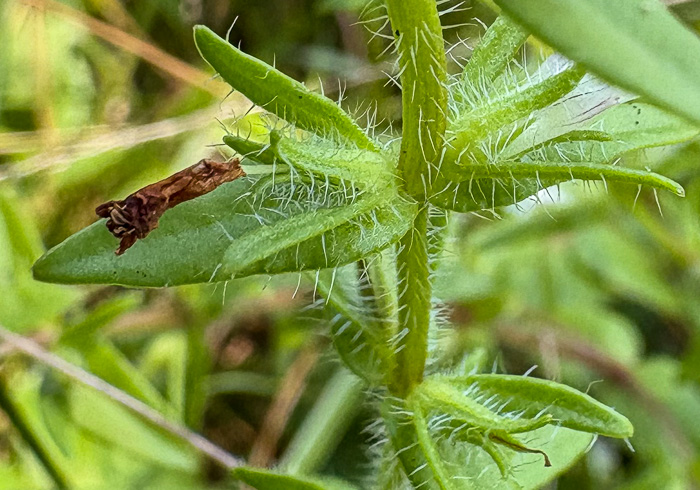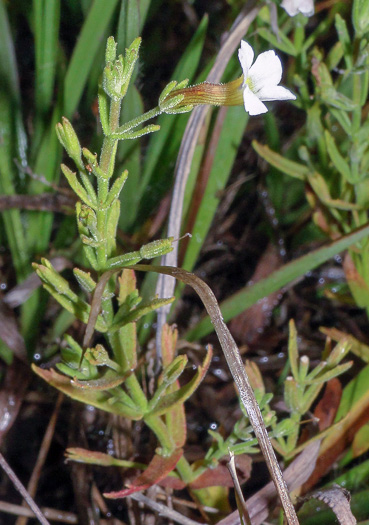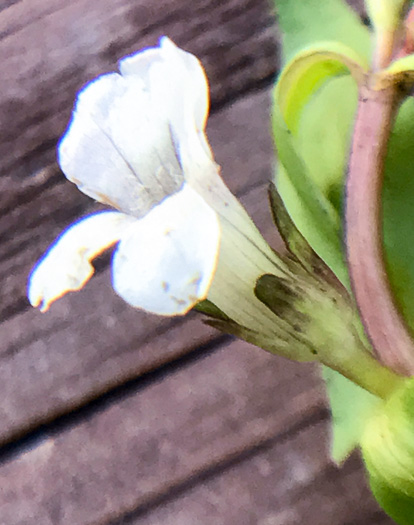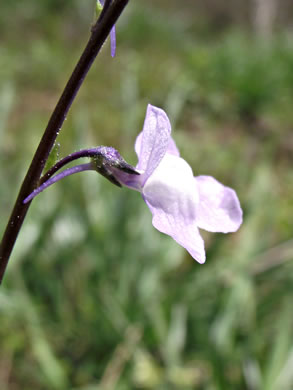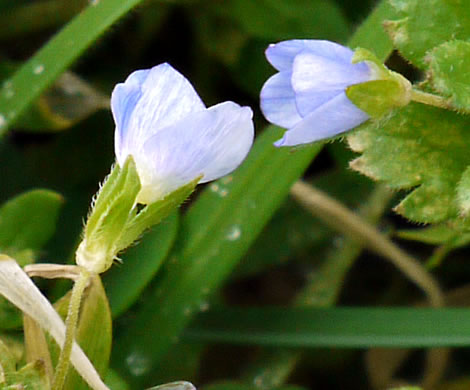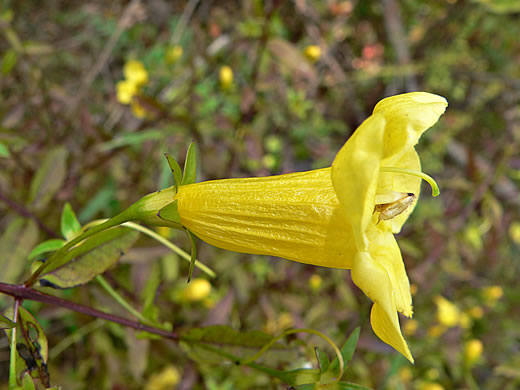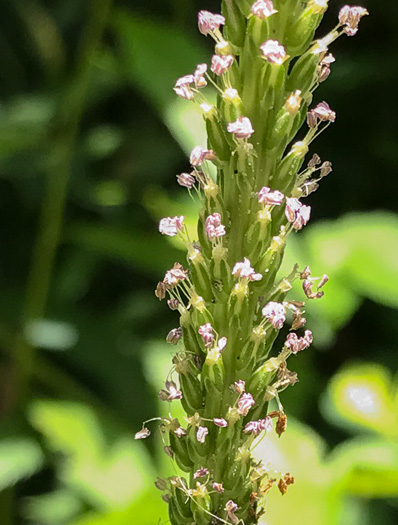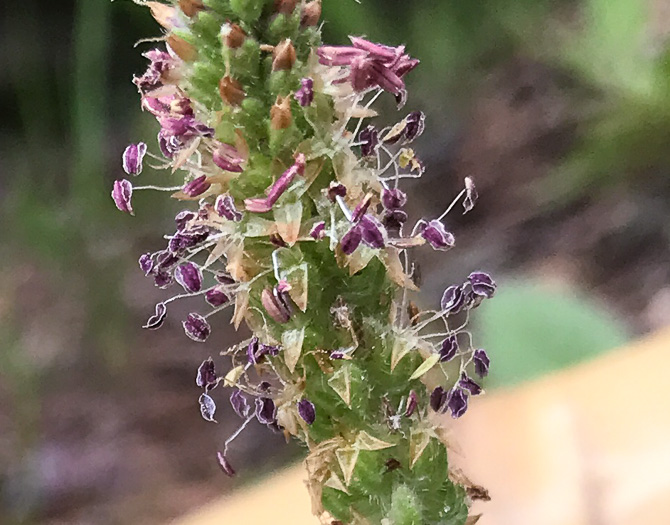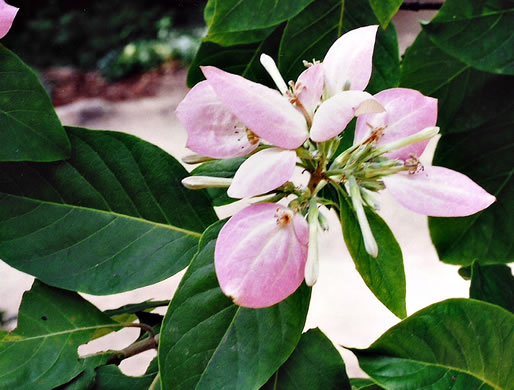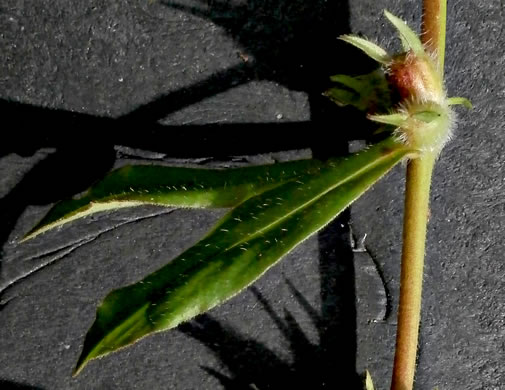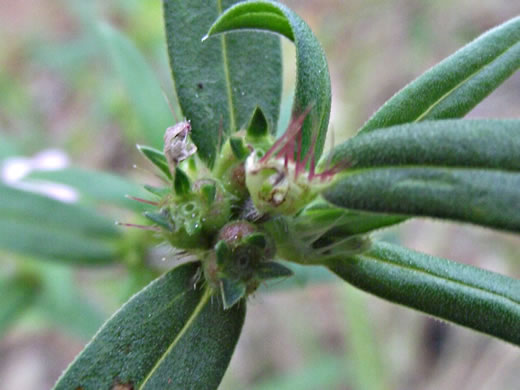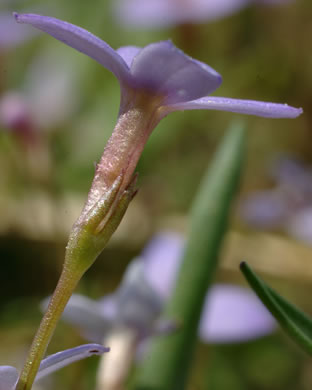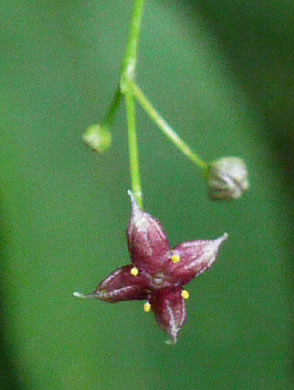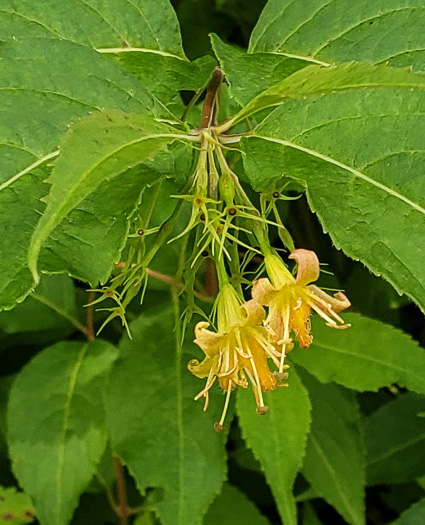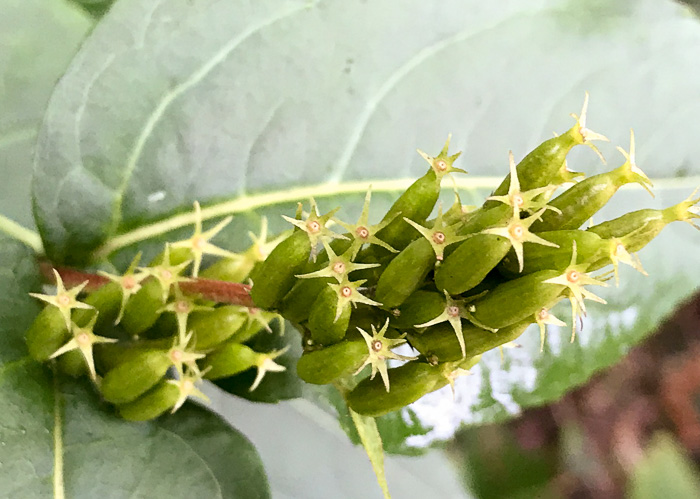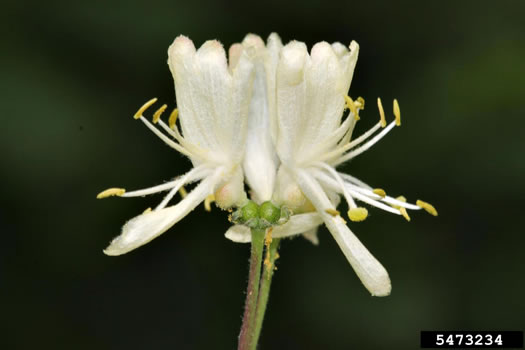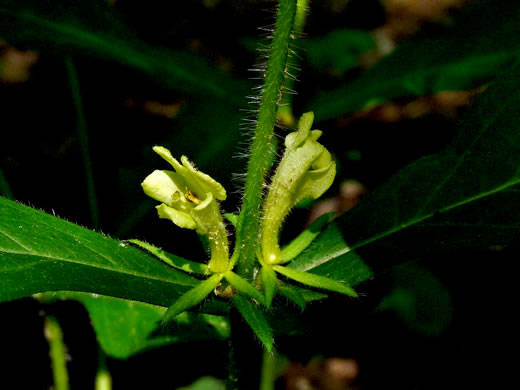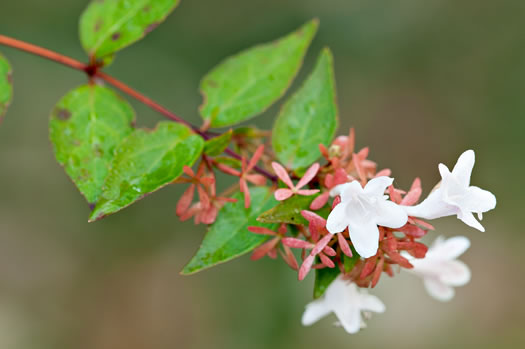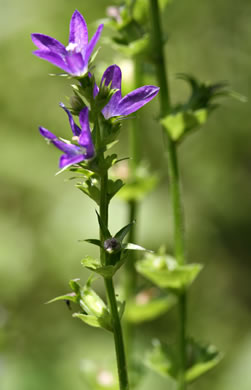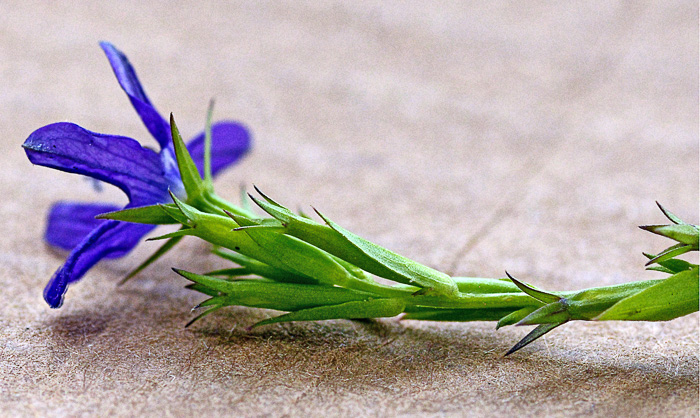Your search found 419 image(s) illustrating the term "sepals." For a written explanation, click on "sepals" in the Glossary.
PAGE 1 PAGE 2 PAGE 3 PAGE 4 PAGE 5 PAGE 6 PAGE 7
To see larger pictures, click or hover over the thumbnails.
To go to the plant's detail page, click its name.
 Black Huckleberry,
Gaylussacia baccata
Black Huckleberry,
Gaylussacia baccata
Sepals 0.7-1mm, glabrous, sessile-glandular, per Flora of North America.
 Bear Huckleberry,
Gaylussacia ursina
Bear Huckleberry,
Gaylussacia ursina
Sepals 0.5mm, glabrous, sparsely sessile-glandular, per Flora of North America.
 Flowering Pyxie-moss,
Pyxidanthera barbulata var. barbulata
Flowering Pyxie-moss,
Pyxidanthera barbulata var. barbulata
Sepals usually pink, per Wildflowers of the Sandhills Region (Sorrie, 2011).
 Godfrey's Forestiera,
Forestiera godfreyi
Godfrey's Forestiera,
Forestiera godfreyi
Flowers subtended by 6 bracts, fringed apically; sepals mostly < 1mm, per Forestiera godfreyi (Oleaceae), a New Species from FL and SC (Anderson, 1985).
 Fringetree,
Chionanthus virginicus
Fringetree,
Chionanthus virginicus
Four sepals, each 1-2mm long, per Vascular Flora of the Carolinas (Radford, Ahles, & Bell, 1968).
 Carolina Jessamine,
Gelsemium sempervirens
Carolina Jessamine,
Gelsemium sempervirens
Pedicels short, bracteate. Sepals lanceolate, separate to base, per Vascular Flora of the Carolinas (Radford, Ahles, & Bell, 1968).
 Indian-pink,
Spigelia marilandica
Indian-pink,
Spigelia marilandica
5 linear sepals, 3-12mm long and tapered from base to apex, per Vascular Flora of the Carolinas (Radford, Ahles, & Bell, 1968).
 Eastern Bluestar,
Amsonia tabernaemontana
Eastern Bluestar,
Amsonia tabernaemontana
The sepals are deltoid and minute, per Vascular Flora of the Carolinas (Radford, Ahles, & Bell, 1968).
 Indian-hemp,
Apocynum cannabinum
Indian-hemp,
Apocynum cannabinum
Sepals lanceolate, minute, per Vascular Flora of the Carolinas (Radford, Ahles, & Bell, 1968).
 Poke Milkweed,
Asclepias exaltata
Poke Milkweed,
Asclepias exaltata
The small green sepals alternate with the larger greenish-white petals.
 Wavyleaf Milkweed,
Asclepias amplexicaulis
Wavyleaf Milkweed,
Asclepias amplexicaulis
Reflexed corolla lobes hide the sepals.
 Eastern Anglepod,
Gonolobus suberosus var. suberosus
Eastern Anglepod,
Gonolobus suberosus var. suberosus
Petals usually more than 2x long as sepals, per Vascular Flora of the Carolinas (Radford, Ahles, & Bell, 1968).
 Swamp Dodder,
Cuscuta gronovii var. gronovii
Swamp Dodder,
Cuscuta gronovii var. gronovii
Flowers not subtended by bracts (or occ. 1 bract). Sepals ~ united basally, per Key to the Dodders (Cuscuta, Convolvulaceae) of Alabama and Adjacent States (Spaulding, 2013).
 Harper's Dodder,
Cuscuta harperi
Harper's Dodder,
Cuscuta harperi
Flowers ~ 1/16" long with 4 green sepals & 4 white petals with upturned tips, per Field Guide to the Rare Plants of Georgia (Chafin, 2007).
 Southern Dawnflower,
Stylisma humistrata
Southern Dawnflower,
Stylisma humistrata
Flwrs mostly in clusters of 2-3 in leaf axils. Sepals without hairs on back, per Atlantic Coastal Plain Wildflowers (Nelson, 2006).
 Common Jacquemontia,
Jacquemontia tamnifolia
Common Jacquemontia,
Jacquemontia tamnifolia
Inflorescence subtended by foliaceous bracts; sepals densely fulvous-hirsute, per Vascular Flora of the Carolinas (Radford, Ahles, & Bell, 1968).
 Twin-flowered Bindweed,
Convolvulus fraterniflorus
Twin-flowered Bindweed,
Convolvulus fraterniflorus
Bracts distinctly overlap and conceal the majority of the sepals, per Key to the Bindweeds (Calystegia/Convolvulus, Convolvulaceae) of Alabama and adjacent states (Spaulding, 2013).
 Blue Ridge Bindweed,
Convolvulus sericatus
Blue Ridge Bindweed,
Convolvulus sericatus
In the genus Calystegia, 2 large bracts below the calyx conceal the sepals, per Wildflowers of the Southern Mountains (Smith, 1998).
 Catesby's Bindweed,
Convolvulus catesbyanus
Catesby's Bindweed,
Convolvulus catesbyanus
Its large bracts almost hide sepals, per Key to the Bindweeds (Calystegia/Convolvulus, Convolvulaceae) of Alabama and adjacent states (Spaulding, 2013).
 Common Morning Glory,
Ipomoea purpurea
Common Morning Glory,
Ipomoea purpurea
Sepals with slightly narrowed green tips shorter than to slightly longer than body of sepal, per Weakley's Flora (2022).
 Common Morning Glory,
Ipomoea purpurea
Common Morning Glory,
Ipomoea purpurea
Sepals subequal, basal half spreading hirsute abaxially. Capsule subglobose, per Flora of China.
 Ivyleaf Morning Glory,
Ipomoea hederacea
Ivyleaf Morning Glory,
Ipomoea hederacea
The hairy sepals have narrow curved-back tips, per Wildflowers of Tennessee, the Ohio Valley, and the Southern Appalachians (Horn, Cathcart, Hemmerly, & Duhl, 2005).
 Ivyleaf Morning Glory,
Ipomoea hederacea
Ivyleaf Morning Glory,
Ipomoea hederacea
Sepals hirsute-villous basally and with a slender tail-like appendage, per Vascular Flora of the Carolinas (Radford, Ahles, & Bell, 1968).
 Ivyleaf Morning Glory,
Ipomoea hederacea
Ivyleaf Morning Glory,
Ipomoea hederacea
Sepals with very narrow elongate green tips much longer than the body of the sepal, per Weakley's Flora (2022).
 Small White Morning Glory,
Ipomoea lacunosa
Small White Morning Glory,
Ipomoea lacunosa
Sepals coriaceous, ovate to ovate-lanceolate, mucronate, margins ciliate, per Vascular Flora of the Carolinas (Radford, Ahles, & Bell, 1968).
 Little-bell,
Ipomoea triloba
Little-bell,
Ipomoea triloba
Sepals 5-7 mm long, oblong, per Weakley's Flora (2023).
 Eastern Blue Phlox,
Phlox divaricata var. divaricata
Eastern Blue Phlox,
Phlox divaricata var. divaricata
Sepals acuminate to very slightly awned, the awn 0-0.5mm long; corolla tube glabrous, per Weakley's Flora (2022).
 Western Blue Phlox,
Phlox divaricata var. laphamii
Western Blue Phlox,
Phlox divaricata var. laphamii
Sepals acuminate to very slightly awned, the awn 0-0.5mm long; corolla tube glabrous, per Weakley's Flora (2022).
 Hairy Phlox,
Phlox amoena
Hairy Phlox,
Phlox amoena
Corollas subtended by stiff hairy 3/8" sepals and conspicuous floral bracts, per Atlantic Coastal Plain Wildflowers (Nelson, 2006).
 Carolina Phlox,
Phlox carolina
Carolina Phlox,
Phlox carolina
The junction-membranes between the sepals are thin, narrow, becoming markedly plicate-keeled, per Weakley's Flora (2025).
 Carolina Phlox,
Phlox carolina
Carolina Phlox,
Phlox carolina
Calyx subcylindric, the sepals fairly broad, with a rather weak midrib, per Weakley's Flora.
 Appalachian Phacelia,
Phacelia dubia var. dubia
Appalachian Phacelia,
Phacelia dubia var. dubia
Outer sepals are lance-shaped, per Wildflowers of Tennessee (Carman, 2005).
 Spotted Phacelia,
Phacelia maculata
Spotted Phacelia,
Phacelia maculata
Sepals have prominent bristles at their margins, per Guide to the Plants of Granite Outcrops (Murdy & Carter, 2000).
 Common Blue Curls,
Trichostema dichotomum
Common Blue Curls,
Trichostema dichotomum
Sepals remain after fruits drop, looking like tiny pointed sugar scoops, per Wildflowers of the Sandhills Region (Sorrie, 2011).
 Mecardonia,
Mecardonia acuminata var. acuminata
Mecardonia,
Mecardonia acuminata var. acuminata
Sepals lanceolate, nearly equal in length, per Weakley's Flora (2012).
 Shaggy Hedge-hyssop,
Sophronanthe pilosa
Shaggy Hedge-hyssop,
Sophronanthe pilosa
Sepals linear or linear-lanceolate, exceeded by the linear bractlets, per Vascular Flora of the Carolinas (Radford, Ahles, & Bell, 1968).
 Branched Hedge-hyssop,
Gratiola ramosa
Branched Hedge-hyssop,
Gratiola ramosa
Sepals 5, sometimes with 1-2 bracts just below, per Wildflowers of the Eastern United States (Duncan & Duncan, 1999).
 Roundfruit Hedge-hyssop,
Gratiola virginiana
Roundfruit Hedge-hyssop,
Gratiola virginiana
Bractlets linear, slightly longer than the sepals. Sepals 4-6mm long, per Aquatic and Wetland Plants of Southeastern United States (Godfrey & Wooten, 1979 & 1981).
 Flatrock Pimpernel,
Lindernia monticola
Flatrock Pimpernel,
Lindernia monticola
Sepals linear-lanceolate, per Vascular Flora of the Carolinas (Radford, Ahles, & Bell, 1968).
 Woolly Mullein,
Verbascum thapsus ssp. thapsus
Woolly Mullein,
Verbascum thapsus ssp. thapsus
Corolla yellow and 5-lobed, 15-25mm wide, within woolly 5-lobed sepals, per Forest Plants of the Southeast and Their Wildlife Uses (Miller & Miller, 2005).
 Oldfield Toadflax,
Linaria canadensis
Oldfield Toadflax,
Linaria canadensis
Curved elongated spur projects downward through calyx; 5 lanceolate sepals, per Forest Plants of the Southeast and Their Wildlife Uses (Miller & Miller, 2005).
 Ivyleaf Speedwell,
Veronica hederifolia
Ivyleaf Speedwell,
Veronica hederifolia
Flowers appear axillary and have 4 distinct sepals. Plant pubescent to pilose, per Vascular Flora of the Carolinas (Radford, Ahles, & Bell, 1968).
 Bird's-eye Speedwell,
Veronica persica
Bird's-eye Speedwell,
Veronica persica
Sepals 4-7mm, lanceolate to ovate, per Jepson eFlora, University of California, Berkeley.
 Cumberland Oak-leach,
Aureolaria patula
Cumberland Oak-leach,
Aureolaria patula
Flowers, sepals and flower stalk covered with tiny soft hairs, per Field Guide to the Rare Plants of Georgia (Chafin, 2007).
 American Plantain,
Plantago rugelii
American Plantain,
Plantago rugelii
Sepals narrowly elliptic, 2-4× long as wide (vs. P. major ~1.5× long as wide), per Weakley's Flora.
 Virginia Plantain,
Plantago virginica
Virginia Plantain,
Plantago virginica
Each tiny flower greenish-white, w a narrow papery corolla w 4 erect lobes & a calyx w 4 sepals, per Wildflowers of the Atlantic Southeast (Cotterman, Waitt, & Weakley, 2019).
 Pinkneya,
Pinckneya bracteata
Pinkneya,
Pinckneya bracteata
1 or more sepals enlarged, petal-like, creamy to rose-colored, conspicuous, per Native Trees of the Southeast, An Identification Guide (Kirkman, Brown, & Leopold, 2007).
 Virginia Buttonweed,
Diodia virginiana
Virginia Buttonweed,
Diodia virginiana
Two 4-6mm long, linear-lanceolate sepals (vs. D. teres has 4 sepals), per Vascular Flora of the Carolinas (Radford, Ahles, & Bell, 1968).
 Poor-joe,
Hexasepalum teres
Poor-joe,
Hexasepalum teres
Fruit capsule somewhat roundish, hairy, & topped by 4 persistent sepals, per Wildflowers of Tennessee (Carman, 2005).
 Tiny Bluet,
Houstonia pusilla
Tiny Bluet,
Houstonia pusilla
4-lobed salverform corolla, 4 lanceolate or subulate sepals, per Vascular Flora of the Carolinas (Radford, Ahles, & Bell, 1968).
 Purple Bedstraw,
Galium latifolium
Purple Bedstraw,
Galium latifolium
Sepals usually obsolete. Corolla maroon, per Vascular Flora of the Carolinas (Radford, Ahles, & Bell, 1968).
 Northern Bush-honeysuckle,
Diervilla lonicera
Northern Bush-honeysuckle,
Diervilla lonicera
Sepals 4-5mm long, per Manual of the Southeastern Flora (JK Small, 1933).
 Smooth Southern Bush-honeysuckle,
Diervilla sessilifolia
Smooth Southern Bush-honeysuckle,
Diervilla sessilifolia
Sepals 2-3mm long, per Manual of the Southeastern Flora (JK Small, 1933).
 European Fly-honeysuckle,
Lonicera xylosteum
European Fly-honeysuckle,
Lonicera xylosteum
Corolla pubescent on the exterior. Bracts, sepals, and ovary glandular, per Weakley's Flora (2012).
 Orange-fruited Horse-gentian,
Triosteum aurantiacum var. aurantiacum
Orange-fruited Horse-gentian,
Triosteum aurantiacum var. aurantiacum
Bright red-orange drupes are about 0.5" long and capped with narrow persistant sepals, per Wildflowers of Tennessee, the Ohio Valley, and the Southern Appalachians (Horn, Cathcart, Hemmerly, & Duhl, 2005).
 Yellowfruit Horse-gentian,
Triosteum angustifolium +
Yellowfruit Horse-gentian,
Triosteum angustifolium +
Flowers greenish-yellow, tubular, w 5 unequal lobes. Sepals w stiff hairs, per Wildflowers of Tennessee, the Ohio Valley, and the Southern Appalachians (Horn, Cathcart, Hemmerly, & Duhl, 2005).
 Abelia,
Abelia ×grandiflora
Abelia,
Abelia ×grandiflora
Flowers white-flushed pink. Sepals persist, evolving rose to purplish tinge, per Manual of Woody Landscape Plants (Dirr, 1975+).
 Clasping Venus's Looking-glass,
Triodanis perfoliata
Clasping Venus's Looking-glass,
Triodanis perfoliata
Sepals lanceolate, acute to acuminate. Bracteal lvs about as wide as long, per Vascular Flora of the Carolinas (Radford, Ahles, & Bell, 1968).
 Southern Venus's Looking-glass,
Triodanis biflora
Southern Venus's Looking-glass,
Triodanis biflora
Sepals lanceolate, acute to acuminate. Bracteal lvs usually longer than wide, per Vascular Flora of the Carolinas (Radford, Ahles, & Bell, 1968).

